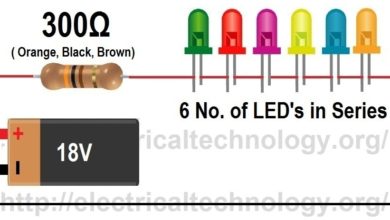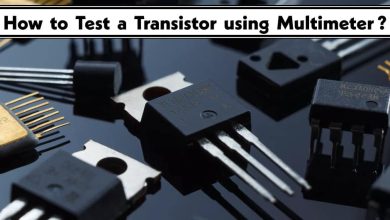Backward Diode: Construction, Operation, Characteristics and Applications
What is a Backward Diode? Symbol, Terminals, Construction, Working, VI Characteristics & Applications
Diode is one of the most essential semiconductor-based electronic components used in almost every piece of electronic equipment. There are different types of diodes manufactured and used for specific applications. One of these types of diodes is the backward diode. It is used to operate in reverse bias and works on quantum tunneling as in tunnel diode allowing it to have a very high switching speed.
What is Backward Diode?
A backward diode or also known as the back diode is a type of PN junction diode that is designed to operate in reverse bias. It has similarities with the Zener diode and tunnel diode. As a matter of fact, it is a modified form of Zener and tunnel diode having combined characteristics of both diodes i.e. the reverse bias operation of the Zener diode and negative resistance or tunneling effect of the tunnel diode.
However, the tunneling effect is reduced which disappears the negative resistance region. It can conduct in both directions however it has lower impedance in reverse bias as compared to forward bias. It has a low operating voltage range.
It is rarely available and is not widely used. However, due to its high switching speed, it is used in high-frequency applications such as RF mixers and multipliers. It can rectify low voltage signals.
Symbol of Backward Diode
The symbol of the backward diode resembles a conventional PN junction diode. It is slightly modified on the cathode side while the anode side remains the same. The bar on the cathode side is modified as shown in the figure below.
In a backward diode, the anode is P-type and the cathode is N type of the PN junction as in a conventional PN junction diode. But the current flow from cathode to anode in the reverse direction as opposed to the PN junction diode. The above fig also shows the P and N terminals of BD4 Back Diode (a type of germanium tunnel diode).
Related Posts
- Zener Diode: Symbol, Construction, Working and Applications
- Tunnel Diode: Symbol, Construction, Working & Applications
Construction
It has a similar construction as a tunnel diode except the doping concentration is kept a little lighter. It helps in aligning the conduction and valance band so that it can conduct like a normal PN diode in forward bias. Thus there is no quantum tunneling or tunnel current in forward bias. However huge tunnel current can flow in reverse bias.
Since the quantum tunneling only occurs in reverse bias, it has lower impedance and it has better conduction in reverse bias. Therefore it is named backward diode.
Working
Backward diode works on the principle of quantum tunneling. It has a similar operation as a tunnel diode except the tunneling occurs in reverse bias. In forward bias, it operates as a normal PN junction diode. It has better current conduction in reverse bias than in forward bias. Its working can be explained using an energy band diagram in different biasing.
Unbiased
In unbiased condition, the back diode is not connected to any power source. The conduction band is at a higher energy level than the valance band. Electron initially resides in the valence band. When they acquire enough energy, they jump into the conduction band leaving behind empty spaces called holes.
In unbiased conditions, there is no current conduction as both conduction and valance band are quite apart from each other. For quantum tunneling, the conduction and valance band of N-type and P-type needs to be on the same level as discussed in reverse bias below.
Related Posts:
- Schottky Diode: Construction, Working and Applications
- Shockley Diode: Construction, Working, Characteristics and Applications
Forward Bias
In forward bias, the anode is connected to a higher potential than the cathode of the back diode. It operates just like a conventional PN junction diode. It does not conduct until the applied voltage cross a certain limit.
The N-type has the majority of electrons and the P-type has the majority of holes. Due to the applied potential, the electrons gain energy and reside in the conduction band of the n-type layer while the holes are in the valance band of the p-type layer. Since in forward bias it operates as a normal diode and the current flow is due to majority carriers, the electrons flow from N-type to P-type layer while the holes move from P-type to N-type in opposite direction resulting in current conduction.
According to the energy band diagram, the gap between the conduction and valance band of the corresponding layer decreases and the electrons gains enough energy to cross the band gap.
Reverse Bias
In reverse bias, the anode is connected to a lower voltage than the cathode of the backward diode. It is usually used in this mode where the quantum tunneling occurs.
According to the energy band figure, due to the application of reverse voltage the gap between the conduction band and the valence band of both layers increases. However, due to an increase in band gap and high doping concentration, the conduction band of the N-type semiconductor and the valence band of the p-type semiconductor falls at the same energy level. Therefore, the electrons can easily pass through the junction known as quantum tunneling. These tunnel electrons give rise to the tunneling current.
Related Posts:
- What is a Diode? Construction and Working of PN Junction Diode
- Types of Diodes and Their Applications
VI Characteristics of Backward Diode
V-I characteristic shows the relationship between the voltage and the current through the device. The x-axis represents the voltage across it while the y-axis represents the current through it. Here is the VI characteristic curve of a backward diode.
In forward bias, it operates as a normal PN junction diode. It has a very small negative resistance region that is almost negligible. Initially its current increases with forward voltage up to a small degree. Further than that the current flow drops and remains constant until the voltage reaches the threshold limit. In reverse bias, the diode acts as a Zener diode with a very low breakdown voltage due to the quantum tunneling.
Advantages & Disadvantages of Backward Diodes
Advantages
Here are some advantages of backward diode
Low Junction Capacitance: Due to its high doping concentration, it has low junction capacitance causing it to have a small recovery time.
High Switching Speed: Due to its low junction capacitance, it has a high switching speed but low operating voltage. Therefore it is best for low voltage RF applications.
Temperature: Temperature has a lower effect on its electrical properties as compared to conventional PN diode. It has lower temperature sensitivity than the PN diode. Therefore temperature variation has no significant effect on it.
Noise: The backward diode has high SNR (signal to noise ratio) as compared to the PN diode. They generate very low noise.
Low Operating Voltage: Backward diode operates on very low voltage. It does not require high voltage like a conventional PN diode to start conduction which is around 0.7 volts.
Efficiency: It has higher efficiency than conventional PN diode for low voltage applications.
Disadvantages
Here are some disadvantages of backward Diode
Low Tunnel Current: Backward diode has a reduced tunneling effect as compared to a tunnel diode therefore it has a lower tunnel current.
Low Voltage: It has a very small depletion region and very low junction capacitance. Therefore it cannot withstand high voltages. It can permanently damage the device. It is only suitable for voltages below 0.6v.
Related Posts:
- Laser Diode: Construction, Working, Types and Applications
- Photodiode: Types, Construction, Operation Modes & Applications
Applications of Back Diode
It is mainly used for its high switching speed. Here are some applications of backward diode
RF Detector: It is used for the detection of RF (radio frequency) in the range of 50 GHz. Due to high doping concentration, it has a very small depletion region that has very low capacitance. This low capacitance allows it to store less charge and switch more quickly. Furthermore, it also shows linear characteristics for small signals.
Switch: Due to the high switching speed of the back diode, it is used as a switch in low voltage microwave frequencies such as RF mixer or multiplier.
Rectifier: It is sometimes used as a low voltage rectifier having a peak voltage below 0.6 volts.
Related Posts:
- LED – Light Emitting Diode: Construction, Working, Types & Applications
- Blocking Diode and Bypass Diodes in a Solar Panel Junction Box
- Difference Between Diode and Transistor
- Difference Between Diode and SCR (Thyristor)
- Difference Between Diode and Transistor
- How to Test a Diode using Digital & Analog Multimeter?
- Diode Formulas & Equations – Zenner, Shockley & Rectifier
- Diode Symbols used for different types of diodes
- Applications of Diodes
- Thyristor and Silicon Controlled Rectifier (SCR) – Thyristors Applications
- MOSFET – Working, Types, Operation, Advantages, and Applications
- IGBT: Construction, Types, Working and Applications
- GTO: Types, Construction, Working and Applications
- DIAC: Symbol, Construction, Working and Applications
- TRIAC: Symbol, Construction, Working and Applications











